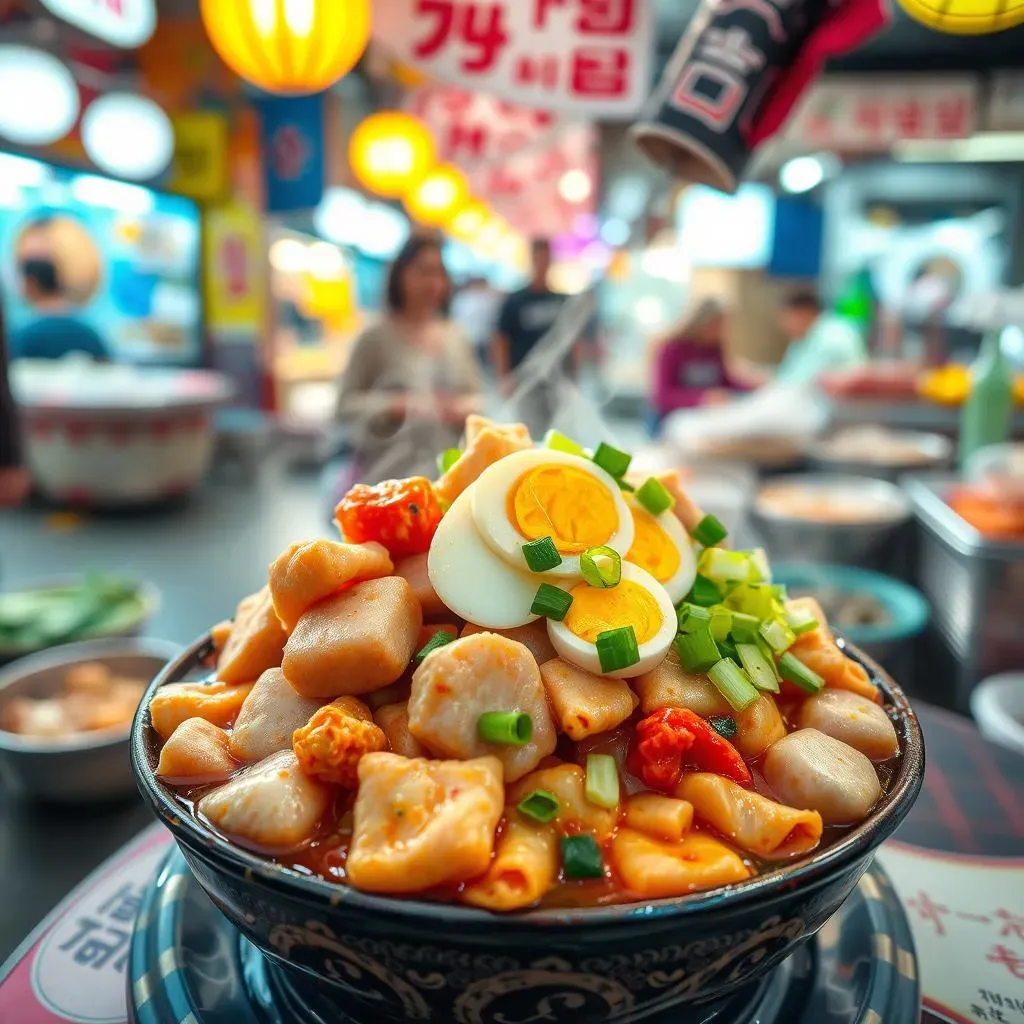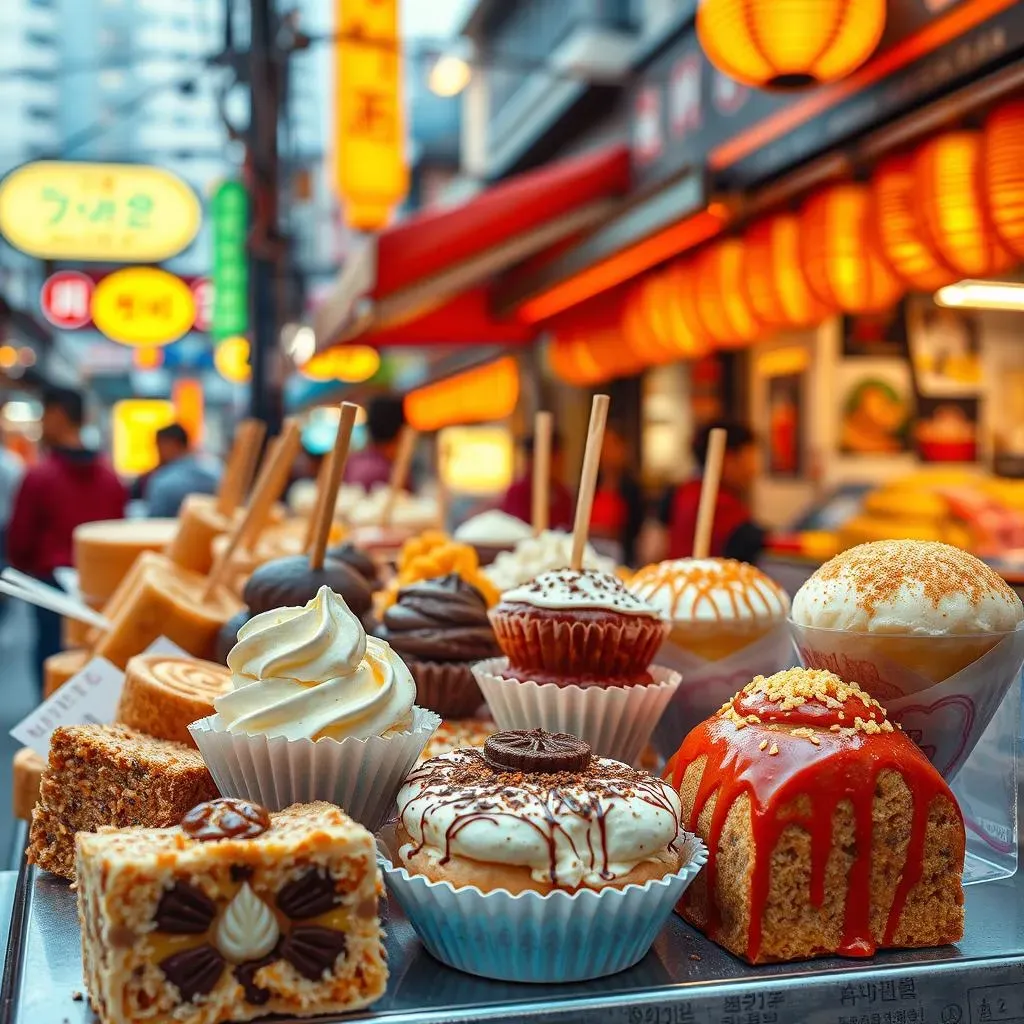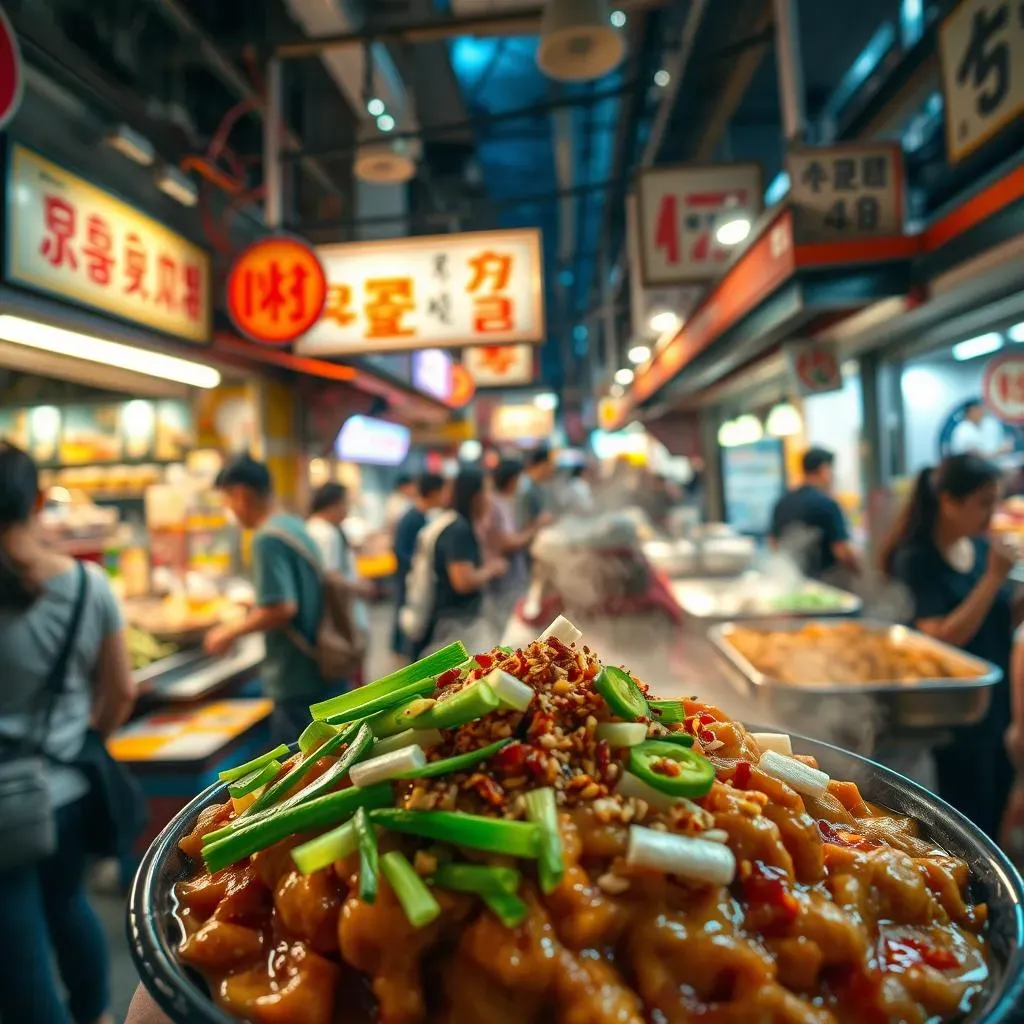Table of Contents
Get ready for a flavor explosion! This article is your passport to the vibrant world of popular Korean street food. Prepare your taste buds for an unforgettable culinary journey as we explore the most beloved savory and sweet treats that define Korean street food culture. We'll uncover the unique stories behind these dishes, from their humble beginnings to their current status as iconic culinary symbols. Discover the rich tapestry of flavors – the fiery spice of tteokbokki, the savory depth of hotteok, and the comforting sweetness of bungeoppang. You'll learn not just what to eat, but also where to find the best popular Korean street food, whether you're exploring bustling markets or cozy alleyways. This isn't just a food guide; it's an invitation to experience the heart and soul of Korean cuisine. So, let's embark on this delicious adventure together and uncover the secrets of popular Korean street food!
Savory Sensations: Popular Korean Street Food Delights
Savory Sensations: Popular Korean Street Food Delights
Tteokbokki: The Spicy Rice Cake Sensation
Let's start with the undisputed king of Korean street food: tteokbokki! These chewy rice cakes, swimming in a vibrant red sauce, are a must-try. The sauce itself is a masterpiece of sweet, spicy, and savory notes, a flavor bomb that will leave you wanting more. Think of it as a culinary rollercoaster; one minute you're enjoying the sweetness, the next you're hit with a wave of satisfying heat. The texture is just as important; the soft, yielding rice cakes provide a delightful contrast to the bold sauce. You'll find countless variations, from the classic to fusion versions like carbonara tteokbokki – a surprisingly delicious combination! Want to learn more about the history of this iconic dish? Check out our post on Korean street food history.
The beauty of tteokbokki lies in its simplicity and adaptability. Street vendors often offer customizable options, letting you adjust the spice level to your liking. Some add fish cakes (eomuk), others throw in sausages or even cheese. It’s a truly versatile dish that caters to every palate. Many vendors also offer a “tteok-soon” combo, pairing tteokbokki with soondae (Korean blood sausage), a truly adventurous culinary experience! Looking for some amazing photos of this dish? Check out our gallery of K-bob Korean street food photos.
Tteokbokki Variation | Description |
|---|---|
Classic | Chewy rice cakes in spicy red sauce |
Fusion (Carbonara) | Creamy, cheesy twist on the classic |
Tteok-soon | Tteokbokki with soondae (blood sausage) |
Beyond Tteokbokki: Other Savory Street Food Stars
While tteokbokki reigns supreme, the world of savory Korean street food is vast and exciting. Consider the delightful experience of eomuk (fish cakes), often served on skewers and simmered in a savory broth. These are inexpensive, readily available, and perfect for a quick bite. The subtle, almost sweet taste of the fish cakes is perfectly complemented by the warm, flavorful broth. Or how about the crispy, golden-brown twigim (deep-fried snacks)? These can range from vegetables to seafood, offering a satisfying crunch with each bite. For a heartier meal, try a bap burger – a Korean twist on the classic burger, using rice patties instead of buns and filled with delicious ingredients like kimchi or bulgogi. Want to know more about the diverse range of Korean street food? Check out our guide to Korean street foods.
Don't forget about the incredible variety of Korean dumplings (mandu)! These can be steamed, boiled, pan-fried, or deep-fried, and filled with an array of delicious ingredients like pork, vegetables, or kimchi. The possibilities are endless! And for something truly unique, try the sundae (blood sausage). While it might sound a bit unusual, it's a surprisingly popular dish with a rich, complex flavor. It's often served with a dipping sauce and enjoyed as a street food snack. Looking for more authentic experiences? Explore our guide to authentic Korean street food for hidden gems.
- Eomuk (fish cakes)
- Twigim (deep-fried snacks)
- Bap burger (rice burger)
- Mandu (dumplings)
- Sundae (blood sausage)
Sweet Treats: Popular Korean Street Food Desserts
Sweet Treats: Popular Korean Street Food Desserts
Hotteok: The Sweet Pancake Delight
Let's move on to the sweet side of Korean street food, and what better place to start than with hotteok? These golden-brown pancakes are filled with a warm, gooey mixture of brown sugar, cinnamon, and peanuts. The contrast between the crispy exterior and the soft, sweet filling is simply divine. Imagine biting into a warm, slightly chewy pancake, the sweet cinnamon filling melting in your mouth – pure bliss! You'll find variations with other fillings, like ice cream or even cheese, offering a delightful twist on the classic. Want to explore more sweet treats? Check out our article on Korean street food desserts.
The preparation of hotteok is a mesmerizing spectacle in itself. Street vendors expertly flatten the dough on a hot griddle, creating a perfectly crisp exterior. The filling is then added, and the pancake is carefully folded, creating a delightful pocket of sweetness. It's a simple yet satisfying treat, perfect for a quick energy boost or a delightful end to a savory street food adventure. Looking for recipes to make your own? Check out our collection of Korean street food recipes.
- Classic Hotteok: Brown sugar, cinnamon, peanuts
- Ice Cream Hotteok: Sweet pancake with ice cream filling
- Cheese Hotteok: Savory-sweet pancake with melted cheese
Bungeoppang: Fish-Shaped Fun
Next up is bungeoppang, a delightful fish-shaped pastry that's a wintertime favorite. These adorable little fish are filled with a sweet red bean paste, providing a warm, comforting treat on a chilly day. The crispy exterior gives way to a soft, slightly sweet filling, creating a wonderful textural contrast. The fish shape itself adds a fun, playful element, making it a popular choice for both kids and adults. It's more than just a snack; it's a charming little piece of Korean street food culture. Looking for more sweet treats? Check out our collection of Korean sweet treats.
While the classic red bean filling is a must-try, you'll also find many inventive variations. Some vendors offer cream fillings, chocolate, or even custard, offering a diverse range of flavors to suit every preference. The preparation is a fascinating process, with the batter poured into fish-shaped molds and cooked to golden perfection. The result is a delightful snack that's both visually appealing and incredibly delicious. For a deeper dive into Korean desserts, see our post on Korean street food desserts.
Bungeoppang Filling | Description |
|---|---|
Red Bean Paste | Classic sweet bean paste filling |
Cream Filling | Rich and creamy, often vanilla or custard |
Chocolate Filling | A decadent chocolate treat |
Beyond the Classics: Other Sweet Delights
While hotteok and bungeoppang are iconic, the world of Korean sweet street food extends far beyond these two. Consider the delightful kkwabaegi, a twisted doughnut coated in cinnamon sugar, offering a satisfyingly sweet and crunchy experience. Or perhaps the delicate dalgona, a honeycomb candy that's both visually stunning and incredibly tasty. It's a nostalgic treat that many associate with childhood memories. And let's not forget the various types of ice cream, often served in unique cones or with creative toppings, offering a refreshing treat on a hot day. Want to find out more about Korean street food culture? Read our article about Korean street food culture.
The diversity of Korean sweet street food reflects the country's rich culinary heritage and its innovative spirit. From classic treats passed down through generations to modern creations that push the boundaries of flavor and presentation, there's something to satisfy every sweet tooth. These desserts aren't merely an afterthought; they're an integral part of the overall street food experience, adding a layer of sweetness and delight to the savory adventures. For a complete guide to Korean street food, check out our comprehensive article on Korean street foods.
- Kkwabaegi (twisted doughnut)
- Dalgona (honeycomb candy)
- Various Ice Creams
Beyond the Bite: The Culture of Popular Korean Street Food
Beyond the Bite: The Culture of Popular Korean Street Food
A Culinary Tapestry
Korean street food isn't just about the food itself; it's a vibrant reflection of Korean culture and history. These snacks aren't just meals; they're a window into the country's past, present, and future. The origins of many dishes are rooted in everyday life, providing affordable and tasty meals for workers and families throughout history. Think of tteokbokki, for example—its popularity soared after the Korean War, offering a cheap yet satisfying meal during times of hardship. This isn't just a dish; it's a testament to resilience and resourcefulness. Want to delve deeper into this fascinating history? Check out our article on Korean street food history.
Street food vendors themselves are an integral part of the cultural landscape. They're often family-run businesses passed down through generations, preserving traditional recipes and techniques. Their lively stalls, filled with the aroma of sizzling food and the chatter of customers, create a sense of community and shared experience. It’s a social gathering as much as a meal. Many vendors have developed unique recipes and techniques, adding their own personal touches to classic dishes. This creates a rich tapestry of flavors and styles, unique to each region and vendor. Interested in learning more about the people behind the food? Explore our piece on Korean street food vendors.
- Affordable and accessible food for all
- Family-run businesses, preserving traditions
- Unique regional variations and recipes
Modern Adaptations and Trends
While tradition plays a significant role, Korean street food is also incredibly dynamic and innovative. Modern trends and fusion cuisine have infused new life into classic dishes, resulting in exciting and unexpected flavor combinations. Imagine tteokbokki with a creamy carbonara sauce, or hotteok filled with ice cream – these aren't your grandmother's street snacks! This constant evolution reflects Korea's vibrant and ever-changing cultural landscape. Want to see some modern twists on these classics? Check out our article on K-bop Korean street food.
Social media has also played a significant role in shaping the popularity of certain street food items. Picturesque dishes, innovative combinations, and quirky presentations have all contributed to the viral spread of certain trends. This online buzz has created a feedback loop, driving demand and encouraging further innovation. The result is a constantly evolving culinary scene, with new and exciting creations emerging all the time. Looking for the hottest new trends? Check out our article about dynamite Korean street food!
Trend | Description |
|---|---|
Fusion Cuisine | Blending traditional dishes with international flavors |
Social Media Influence | Viral trends shaping popularity and innovation |
Regional Variations | Unique recipes and styles specific to certain areas |
Finding Your Fix: Where to Find Popular Korean Street Food
Finding Your Fix: Where to Find Popular Korean Street Food
Seoul's Street Food Hotspots
Seoul is a street food paradise! Myeongdong is legendary, a bustling street packed with vendors selling everything from spicy tteokbokki to sweet hotteok. Expect crowds, but the vibrant atmosphere and delicious food make it worth it. Insadong offers a more cultural experience, with traditional snacks nestled amongst art galleries and tea houses. Hongdae, known for its youthful energy, has a unique selection of trendy street food stalls, often with creative twists on classic dishes. Want to know more about specific locations? Check out our guide to Korean street food locations.
Beyond these main areas, explore smaller neighborhoods and local markets. You'll discover hidden gems and experience a more authentic side of Korean street food culture. Each market has its own character, offering a unique culinary adventure. Namdaemun Market, for example, is a historic marketplace with a wide array of food stalls, offering a blend of traditional and modern treats. Looking for something more specialized? Check out our article on Korean street food markets.
- Myeongdong: Bustling, classic street food scene
- Insadong: Cultural setting with traditional snacks
- Hongdae: Trendy, youthful vibe with innovative food
- Namdaemun Market: Historic market with diverse options
Beyond Seoul: Nationwide Delights
While Seoul is a street food mecca, don't limit yourself! Other cities across South Korea boast unique and delicious street food scenes. Busan, a coastal city, offers fresh seafood and regional specialties. Jeonju, known for its rich culinary heritage, features bibimbap-inspired street food. These regional variations add another layer to the overall street food experience, offering a glimpse into the diverse flavors of the country. For more details on different cities, check out our post on Korean street food locations.
No matter where you find yourself in South Korea, keep your eyes peeled for street food stalls. They're often located near popular tourist attractions, transportation hubs, and local markets. Don't be afraid to venture off the beaten path; you might just stumble upon a hidden gem serving up the best tteokbokki you've ever tasted! For a more in-depth look at finding authentic street food, see our guide on authentic Korean street food.
City | Specialty |
|---|---|
Busan | Fresh seafood |
Jeonju | Bibimbap-inspired dishes |
Other Cities | Unique regional variations |
Tips for Your Street Food Adventure
To truly savor the experience, embrace the local culture. Don't be afraid to try new things, even if they seem a little unusual at first. Engage with the vendors; many are happy to share stories about their food and their family traditions. Be mindful of local customs and etiquette; for example, it's generally polite to use cash when buying street food. For a broader understanding of Korean culture related to food, check out our article on Korean street food culture.
Most importantly, have fun! Korean street food is a delicious and exciting adventure, a chance to connect with the local culture and savor some truly unique and unforgettable flavors. Remember to pace yourself; there's so much to try! And don't forget to take photos to share your experience with friends and family. Looking for some inspiration? Check out our gallery of Korean street food photos.
- Try new things!
- Engage with the vendors.
- Be mindful of local customs.
- Take lots of photos!